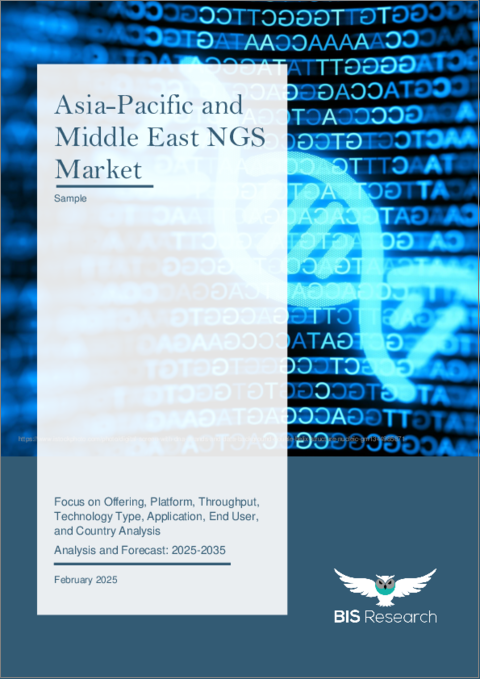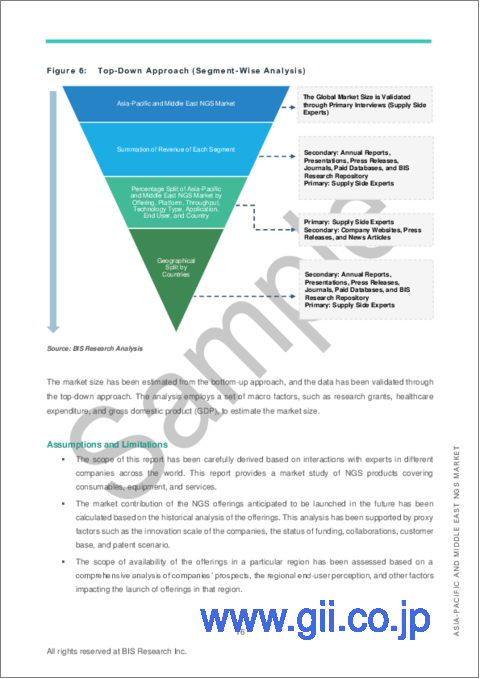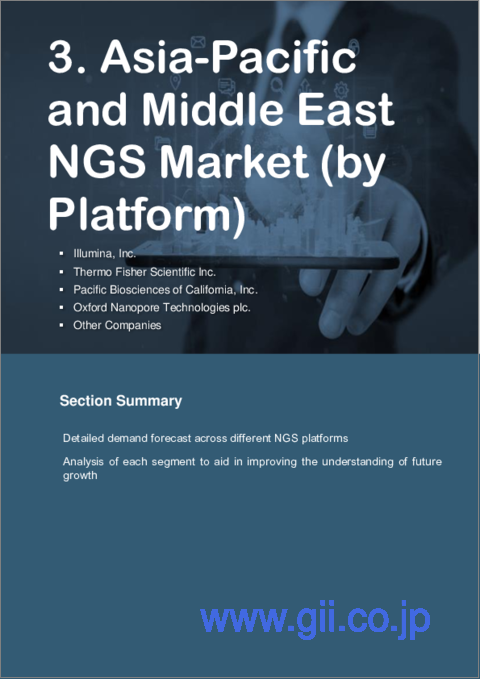|
|
市場調査レポート
商品コード
1679111
アジア太平洋および中東のNGS市場:オファリング別、ワークフロー別、プラットフォーム別、スループット別、技術タイプ別、用途別、エンドユーザー別、国別 - 分析と予測(2025年~2035年)Asia-Pacific and Middle East NGS Market: Focus on Offering, Platform, Throughput, Technology Type, Application, End User, and Country Analysis - Analysis and Forecast, 2025-2035 |
||||||
カスタマイズ可能
|
|||||||
| アジア太平洋および中東のNGS市場:オファリング別、ワークフロー別、プラットフォーム別、スループット別、技術タイプ別、用途別、エンドユーザー別、国別 - 分析と予測(2025年~2035年) |
|
出版日: 2025年03月14日
発行: BIS Research
ページ情報: 英文 110 Pages
納期: 1~5営業日
|
全表示
- 概要
- 目次
アジア太平洋および中東の次世代シーケンシング(NGS)市場は、次世代シーケンシング技術の急速な進歩、遺伝性疾患やがんの有病率の上昇、精密医療における次世代シーケンシングの応用拡大などを背景に、大きな成長を遂げています。
次世代シーケンシングプラットフォームの絶え間ない技術革新により、効率性、精度、費用対効果が向上し、次世代シーケンシングは臨床診断と研究の両方の目的でより利用しやすくなっています。個別化医療、特に腫瘍学、生殖医療、感染症診断における次世代シーケンシングへの需要の高まりが、市場の拡大をさらに後押ししています。さらに、政府の強力なイニシアチブ、研究開発投資の増加、バイオテクノロジー企業とヘルスケアプロバイダーとの戦略的提携が、この地域における次世代シーケンシングの成長を後押ししています。中国、インド、サウジアラビアなどの国々は、病気の早期発見と精密ヘルスケアを推進するための大規模ゲノムプロジェクトを主導しており、アジア太平洋および中東のNGS市場展望をさらに強化しています。
次世代シーケンシング市場は大きな成長の可能性を秘めていますが、いくつかの課題も残っています。次世代シーケンシングプラットフォーム、消耗品、データ解析ツールに関連する高コストは、特に低所得地域において、依然として大きな障壁となっています。バイオインフォマティクスやゲノムデータの解釈に習熟した専門家の不足が、次世代シーケンシング技術の普及をさらに妨げています。さらに、データのプライバシー、セキュリティ、および規制コンプライアンスに関する懸念が、さまざまな国での次世代シーケンシングの実施に複雑さをもたらしています。さらに、ヘルスケア規制のばらつきやゲノムデータ利用をめぐる倫理的な懸念が市場の抑制要因に拍車をかけ、特定の地域での次世代シーケンシングの採用をより困難なものにしています。この要因は、アジア太平洋および中東のNGS市場に課題をもたらしています。
とはいえ、アジア太平洋および中東地域の次世代シーケンシング市場には大きな拡大機会があります。ヘルスケアインフラが急速に改善しつつある新興国では、次世代シーケンシングの研究や臨床アプリケーションへの投資が増加しています。人工知能(AI)とクラウドベースのバイオインフォマティクスの統合はゲノムデータ解析に革命をもたらし、次世代シーケンシングをより効率的で利用しやすいものにしています。さらに、非侵襲的出生前検査(NIPT)や感染症研究における次世代シーケンシングの利用の拡大は、市場参入企業に新たな成長の道を提供しています。政府や非公開会社がゲノム研究、精密医療、臨床応用への投資を続ける中、アジア太平洋および中東の次世代シーケンシング市場は今後数年で大幅に拡大する見通しです。
当レポートでは、アジア太平洋および中東のNGS市場について調査し、市場の概要とともに、オファリング別、ワークフロー別、プラットフォーム別、スループット別、技術タイプ別、用途別、エンドユーザー別、国別の動向、および市場に参入する企業のプロファイルなどを提供しています。
目次
エグゼクティブサマリー
調査範囲
調査手法
第1章 アジア太平洋および中東のNGS市場概要
- 市場見通し
- 業界展望
- 市場力学
第2章 アジア太平洋および中東のNGS市場分析(オファリング別)、100万米ドル、2024年~2035年
- 消耗品
- 装置
- サービス
第3章 アジア太平洋および中東のNGS市場分析(ワークフロー別)、100万米ドル、2024年~2035年
- シーケンシング
- 事前シーケンス
- データ分析
第4章 アジア太平洋および中東のNGS市場分析(プラットフォーム別)、100万米ドル、2024年~2035年
- 概要
- Illumina, Inc.
- Thermo Fisher Scientific, Inc.
- Pacific Biosciences of California, Inc.
- Oxford Nanopore Technologies plc.
- その他の企業
第5章 アジア太平洋および中東のNGS市場分析(スループット別)、100万米ドル、2024年~2035年
- 概要
- 高スループット
- 中程度のスループット
- 低スループット
第6章 アジア太平洋および中東のNGS市場分析(技術タイプ別)、100万米ドル、2024年~2035年
- 合成におけるシーケンシング
- イオントレント半導体シーケンシング
- 単一分子リアルタイムシーケンシング
- ナノポアシーケンシング技術
- その他
第7章 アジア太平洋および中東のNGS市場分析(用途別)、100万米ドル、2024年~2035年
- 臨床診断
- トランスレーショナルリサーチ
第8章 アジア太平洋および中東のNGS市場分析(エンドユーザー別)、100万米ドル、2024年~2035年
- 製薬会社・バイオテクノロジー企業
- 学術研究機関
- 臨床検査室
- その他
第9章 アジア太平洋NGS市場分析(国別)、100万米ドル、2024年~2035年
- 市場概要
- 市場規模と予測
- 日本
- 中国
- インド
- 韓国
- オーストラリア
- シンガポール
- ニュージーランド
- その他
第10章 中東のNGS市場分析(国別)、100万米ドル、2024年~2035年
- 市場概要
- 市場規模と予測
- アラブ首長国連邦
- サウジアラビア
- イスラエル
- エジプト
- その他
第11章 アジア太平洋および中東のNGS市場-競合ベンチマーキングと企業プロファイル
- 競合ベンチマーキング
- 競合情勢
- 各社の主な戦略と展開
- 市場シェア分析、2024-2035
- アジア太平洋および中東のNGS市場の成長シェア分析(エンドユーザー別)
- アジア太平洋および中東のNGS市場の成長シェア分析(スループット別)
- 企業プロファイル
- BGI Group
- Illumina, Inc.
- Thermo Fisher Scientific, Inc.
- Pacific Biosciences of California, Inc.
- Oxford Nanopore Technologies plc
- 新興企業(アジア太平洋および中東)
Asia-Pacific and Middle East NGS Market Industry Overview
The Asia-Pacific and Middle East Next-Generation Sequencing (NGS) market is experiencing significant growth, driven by rapid advancements in next-generation sequencing technologies, the rising prevalence of genetic disorders and cancer, and the expanding application of next-generation sequencing in precision medicine. Continuous innovations in next-generation sequencing platforms have enhanced efficiency, accuracy, and cost-effectiveness, making next-generation sequencing more accessible for both clinical diagnostics and research purposes. The increasing demand for next-generation sequencing in personalized medicine, particularly in oncology, reproductive health, and infectious disease diagnostics, is further fueling market expansion. Additionally, strong government initiatives, increased R&D investments, and strategic collaborations between biotech firms and healthcare providers are propelling the growth of next-generation sequencing in the region. Countries such as China, India, and Saudi Arabia are leading large-scale genomic projects to advance early disease detection and precision healthcare, further strengthening the Asia-Pacific and Middle East NGS market landscape.
Despite the strong growth potential of the next-generation sequencing market, several challenges persist. The high cost associated with next-generation sequencing platforms, consumables, and data analysis tools remains a major barrier, particularly in low-income regions. The shortage of skilled professionals proficient in bioinformatics and genomic data interpretation further hinders the widespread adoption of next-generation sequencing technologies. Moreover, concerns related to data privacy, security, and regulatory compliance create complexities in the implementation of next-generation sequencing across different countries. Additionally, variations in healthcare regulations and ethical concerns surrounding genomic data usage add to the market's constraints, making the adoption of next-generation sequencing more challenging in certain regions. This factor is posing a challenge for the Asia-Pacific and Middle East NGS market.
Nevertheless, the next-generation sequencing market in the Asia-Pacific and Middle East regions presents significant opportunities for expansion. Emerging economies with rapidly improving healthcare infrastructure are increasingly investing in next-generation sequencing research and clinical applications. The integration of artificial intelligence (AI) and cloud-based bioinformatics is revolutionizing genomic data analysis, making next-generation sequencing more efficient and accessible. Furthermore, the growing use of next-generation sequencing in non-invasive prenatal testing (NIPT) and infectious disease research offers new growth avenues for market players. As governments and private sector companies continue investing in genomic research, precision medicine, and clinical applications, the next-generation sequencing market in Asia-Pacific and the Middle East is poised for substantial expansion in the coming years.
Impact of COVID-19
Next-generation sequencing (NGS)-based products play a vital role in disease research and diagnostics, particularly in cancer detection and treatment, where next-generation sequencing enables personalized and targeted therapies for patients. The next-generation sequencing market is primarily driven by manufacturers of next-generation sequencing instruments, kits, assays, and service providers offering gene panels and oncology-focused testing services using next-generation sequencing technology. However, the COVID-19 pandemic negatively impacted revenue growth in the next-generation sequencing market due to disruptions in supply chains and healthcare operations, affecting the availability of next-generation sequencing products and services.
Despite these challenges, the pandemic underscored the critical role of next-generation sequencing in public health management, particularly in sequencing the SARS-CoV-2 virus, tracking its mutations, and monitoring population health. For example, in October 2022, Kyrgyzstan initiated efforts to enhance its next-generation sequencing capabilities for SARS-CoV-2 surveillance. Industry leaders in next-generation sequencing anticipate a shift toward local manufacturing to reduce dependence on imports, as the pandemic exposed weaknesses in global supply chains. Consequently, several countries in the Asia-Pacific and Middle East regions are prioritizing domestic production of essential medical supplies and next-generation sequencing tools to ensure a more stable and resilient healthcare infrastructure, propelling the the overall Asia-Pacific and Middle East NGS market.
The growth of the next-generation sequencing market is fueled by the increasing adoption of next-generation sequencing in diverse research and diagnostic applications, the rising prevalence of non-communicable diseases, and continuous advancements in next-generation sequencing platforms that enhance efficiency, speed, and accuracy. As the demand for next-generation sequencing continues to rise, innovations in next-generation sequencing technology will further drive market expansion, positioning next-generation sequencing as a fundamental tool in modern genomics and precision medicine.
Market Segmentation:
Segmentation 1: by Offerings
- Consumables
- Equipment
- Services
The Asia-Pacific and Middle East NGS market (by offerings) is expected to be dominated by the consumables segment.
Segmentation 2: by Platform
- Illumina, Inc.
- Thermo Fisher Scientific Inc.
- Pacific BioSciences of California, Inc.
- Oxford Nanopore Technologies plc.
- Other Companies
The Asia-Pacific and Middle East NGS market (by platform) is expected to be dominated by Illumina, Inc.
Segmentation 3: by Throughput
- High-Throughput
- Medium-Throughput
- Low-Throughput
The Asia-Pacific and Middle East NGS market (by throughput) is expected to be dominated by the high-throughput segment.
Segmentation 4: by Technology Type
- Sequencing by Synthesis
- In Torrent Semiconductor Sequencing
- Single Molecule Real-Time Sequencing
- Nanopore Sequencing Technology
- Other Technologies
The Asia-Pacific NGS market (by technology type) is expected to be dominated by the sequencing by synthesis segment.
Segmentation 5: by Application
- Clinical Diagnostics
- Translational Research
- Other Applications
The Asia-Pacific NGS market (by technology type) is expected to be dominated by the translational research segment.
Segmentation 6: by End User
- Academic and Research Institutes
- Clinical Laboratories
- Pharmaceutical and Biotechnology Companies
- Other End Users
The Asia-Pacific NGS market (by end user) is expected to be dominated by the academic and research insitutes segment.
Segmentation 7: by Country
- Asia-Pacific
- Japan
- India
- South Korea
- Australia
- Singapore
- New Zealand
- Rest-of-Asia-Pacific
- Middle East
- U.A.E.
- K.S.A.
- Egypt
- Israel
- Rest-of-Middle East
The Asia-Pacific NGS market (by country) is expected to be dominated by Japan and the Middle East NGS market (by country) is expected to be dominated by the U.A.E.
Recent Developments in the Asia-Pacific and Middle East NGS Market
- In October 2022, PacBio introduced Revio and Onso, two new sequencing systems. Revio is a long-read sequencing system capable of sequencing up to 1,300 human whole genomes annually, while Onso is a benchtop short-read DNA sequencing platform. These systems enhance the scalability of PacBio's HiFi sequencing technology, supporting large-scale studies in human genetics, oncology, and agricultural genomics.
- In September 2022, Illumina, Inc. launched Illumina Complete Long-Reads (INFINITY) for whole-genome sequencing (WGS). This innovation provided a high-performance, fully integrated sequencing method, compatible with all NovaSeq systems, enabling the synthesis of thousands of long-read genomes per year.
- Also in September 2022, Illumina, Inc. unveiled the NovaSeq 6000 Dx, the first FDA-registered and CE-marked high-throughput in vitro diagnostic (IVD) sequencer. Designed for clinical applications, this platform ensures high compliance standards while delivering critical insights to improve patient care.
- In August 2022, Illumina, Inc. partnered with the Minderoo Foundation, investing $27.8 million to advance genetic research on marine ecosystems. This collaboration utilized Illumina's NextSeq 2000 sequencing system to analyze marine biodiversity and better understand oceanic life.
- In April 2022, Genomics England extended its partnership with a sequencing company to explore the therapeutic and scientific potential of comprehensive genomic analysis of cancer tumors using nanopore sequencing technology as part of an ongoing project.
- In March 2022, a sequencing company launched the CE-IVD marked Ion Torrent Genexus Dx Integrated Sequencer, a fully automated system capable of generating sequencing data within a single day, streamlining diagnostic processes.
- In January 2022, Pacific Biosciences of California, Inc. collaborated with Genomics England to further the 100,000 Genomes Project by leveraging long-read sequencing technology to detect genetic variants in cancer and rare disease cases. As part of this initiative, Genomics England re-sequenced biobank samples to identify additional genomic variations that short-read sequencing technologies might not effectively capture.
Demand - Drivers and Limitations
The following are the drivers for the Asia-Pacific and Middle East NGS market:
- Increasing Adoption of NGS in Various Research and Diagnostics Field
- Growing Prevalence of Non-Communicable Diseases is Boosting the Demand for NGS
- Advancement in the Performance of NGS Platforms
The market is expected to face some limitations as well due to the following challenges:
- Dearth of Skilled Professionals in Middle East Countries
- High Cost of Installation and Maintenance of the Equipment
- Reimbursement and Regulatory Policies of NGS
How can this report add value to an organization?
Type: The Asia-Pacific and Middle East NGS market has been extensively segmented on the basis of various categories such as offerings, throughput, and platform, among others. This can help readers get a clear overview of which segments account for the largest share and which ones are well-positioned to grow in the coming years.
Growth/Marketing Strategy: Synergistic activities and product launches/approvals accounted for the maximum number of key developments, i.e., over 70% of the total developments in the global Asia-Pacific and Middle East NGS market.
Competitive Strategy: The Asia-Pacific and Middle East NGS market is highly consolidated, with around six key players accounting for a vast majority of the market share. Key players in the Asia-Pacific and Middle East NGS market analyzed and profiled in the study involve established and players that offer various kinds of NGS platforms, consumables, and services.
Table of Contents
Executive Summary
Scope of the Study
Research Methodology
1. Asia-Pacific and Middle East NGS Market Overview
- 1.1 Market Outlook
- 1.1.1 Definitions
- 1.1.2 Inclusion and Exclusion Criteria
- 1.1.3 Market Size, 2024 - 2035, $Million
- 1.1.4 Key Findings
- 1.1.5 Market Growth Scenario
- 1.1.5.1 Realistic Scenario
- 1.1.5.2 Optimistic Scenario
- 1.1.5.3 Pessimistic Scenario
- 1.2 Industry Outlook
- 1.2.1 NGS: Market Overview and Ecosystem
- 1.2.2 Asia-Pacific and Middle East NGS: Overview
- 1.2.3 Key Trends and Emerging Application of NGS in Asia-Pacific and Middle East
- 1.2.4 Patent Analysis
- 1.2.5 Pricing Analysis
- 1.2.5.1 Instrument
- 1.2.5.2 Consumables
- 1.2.6 Supply Chain Analysis
- 1.2.6.1 Key Entities in Supply Chain
- 1.2.7 Regulatory Framework
- 1.2.7.1 Asia-Pacific
- 1.2.7.2 Middle East
- 1.2.8 Genome Projects
- 1.2.8.1 Asia-Pacific
- 1.2.8.1.1 China
- 1.2.8.1.2 Japan
- 1.2.8.1.3 India
- 1.2.8.1.4 South Korea
- 1.2.8.1.5 Singapore
- 1.2.8.1.6 Other Asian Countries
- 1.2.8.2 Middle East
- 1.2.8.2.1 UAE
- 1.2.8.2.2 Qatar
- 1.2.8.2.3 Saudi Arabia
- 1.2.8.2.4 Kuwait
- 1.2.8.2.5 Other Middle East Countries
- 1.2.8.1 Asia-Pacific
- 1.3 Market Dynamics
- 1.3.1 Market Drivers
- 1.3.1.1 Impact Analysis
- 1.3.2 Market Restraints
- 1.3.2.1 Impact Analysis
- 1.3.3 Market Opportunities
- 1.3.1 Market Drivers
2. Asia-Pacific and Middle East NGS Market Analysis (By Offering), $Million, 2024-2035
- 2.1 Consumables
- 2.1.1 Library Preparation and Reagents
- 2.1.2 Sequencing Kits and Reagents
- 2.1.3 Others
- 2.2 Equipment
- 2.3 Services
- 2.3.1 Sequencing Services
- 2.3.2 Data Management Services
3. Asia-Pacific and Middle East NGS Market Analysis (By Workflow), $Million, 2024-2035
- 3.1 Sequencing
- 3.2 Pre-Sequencing
- 3.3 Data Analysis
4. Asia-Pacific and Middle East NGS Market Analysis (By Platform), $Million, 2024-2035
- 4.1 Overview
- 4.1.1 Asia-Pacific
- 4.1.2 Middle East
- 4.2 Illumina, Inc. (Asia-Pacific and Middle East)
- 4.2.1 iSeq
- 4.2.2 MiniSeq
- 4.2.3 MiSeq
- 4.2.4 NextSeq
- 4.2.5 NovaSeq
- 4.3 Thermo Fisher Scientific, Inc. (Asia-Pacific and Middle East)
- 4.3.1 Ion PGM
- 4.3.2 Ion Genestudio S5
- 4.3.3 Ion Proton
- 4.3.4 Ion Genexus
- 4.4 Pacific Biosciences of California, Inc. (Asia-Pacific and Middle East)
- 4.4.1 Sequel II/IIe
- 4.5 Oxford Nanopore Technologies plc. (Asia-Pacific and Middle East)
- 4.5.1 MinION
- 4.5.2 GridION
- 4.5.3 PromethION
- 4.6 Other Companies (Asia-Pacific and Middle East)
5. Asia-Pacific and Middle East NGS Market Analysis (By Throughput), $Million, 2024-2035
- 5.1 Overview
- 5.1.1 Asia-Pacific
- 5.1.2 Middle East
- 5.2 High-Throughput
- 5.3 Medium-Throughput
- 5.4 Low-Throughput
6. Asia-Pacific and Middle East NGS Market Analysis (By Technology Type), $Million, 2024-2035
- 6.1 Sequencing by Synthesis
- 6.2 Ion Torrent Semiconductor Sequencing
- 6.3 Single Molecule Real-time Sequencing
- 6.4 Nanopore Sequencing Technologies
- 6.5 Other Technologies
7. Asia-Pacific and Middle East NGS Market Analysis (By Application), $Million, 2024-2035
- 7.1 Clinical Diagnostics
- 7.1.1 Oncology
- 7.1.2 Infectious Diseases
- 7.1.3 Reproductive Genetics
- 7.1.4 Others
- 7.2 Translational Research
- 7.2.1 Clinical
- 7.2.2 Agricultural
- 7.2.3 Others
8. Asia-Pacific and Middle East NGS Market Analysis (By End User), $Million, 2024-2035
- 8.1 Pharmaceutical and Biotechnology Companies
- 8.2 Academic and Research Institution
- 8.3 Clinical Laboratories
- 8.4 Others
9. Asia-Pacific NGS Market Analysis (By Country), $Million, 2024-2035
- 9.1 Market Overview
- 9.2 Market Sizing and Forecast
- 9.2.1 Japan
- 9.2.2 China
- 9.2.3 India
- 9.2.4 South Korea
- 9.2.5 Australia
- 9.2.6 Singapore
- 9.2.7 New Zealand
- 9.2.8 Rest of Asia-Pacific
10. Middle East NGS Market Analysis (By Country), $ Million, 2024-2035
- 10.1 Market Overview
- 10.2 Market Sizing and Forecast
- 10.2.1 UAE
- 10.2.2 KSA
- 10.2.3 Israel
- 10.2.4 Egypt
- 10.2.5 Rest-of-Middle East
11. Asia-Pacific and Middle East NGS Market - Competitive Benchmarking and Company Profiles
- 11.1 Competitive Benchmarking
- 11.2 Competitive Landscape
- 11.2.1 Key Strategies and Developments by Company
- 11.2.1.1 Funding Activities
- 11.2.1.2 Mergers and Acquisitions
- 11.2.1.3 Regulatory Approvals
- 11.2.1.4 Partnerships, Collaborations, and Business Expansions
- 11.2.2 Market Share Analysis, 2024-2035
- 11.2.3 Growth Share Analysis for Asia-Pacific and Middle East NGS Market (by End User)
- 11.2.4 Growth Share Analysis for Asia-Pacific and Middle East NGS Market (by Throughput)
- 11.2.1 Key Strategies and Developments by Company
- 11.3 Company Profiles
- 11.3.1 BGI Group
- 11.3.1.1.1 Company Overview
- 11.3.1.1.2 Product Portfolio
- 11.3.1.1.3 Key Competitors
- 11.3.1.1.4 Target Customers
- 11.3.1.1.5 Analyst Perspective
- 11.3.2 Illumina, Inc.
- 11.3.2.1.1 Company Overview
- 11.3.2.1.2 Product Portfolio
- 11.3.2.1.3 Key Competitors
- 11.3.2.1.4 Target Customers
- 11.3.2.1.5 Analyst Perspective
- 11.3.3 Thermo Fisher Scientific, Inc.
- 11.3.3.1.1 Company Overview
- 11.3.3.1.2 Product Portfolio
- 11.3.3.1.3 Key Competitors
- 11.3.3.1.4 Target Customers
- 11.3.3.1.5 Analyst Perspective
- 11.3.4 Pacific Biosciences of California, Inc.
- 11.3.4.1.1 Company Overview
- 11.3.4.1.2 Product Portfolio
- 11.3.4.1.3 Key Competitors
- 11.3.4.1.4 Target Customers
- 11.3.4.1.5 Analyst Perspective
- 11.3.5 Oxford Nanopore Technologies plc
- 11.3.5.1.1 Company Overview
- 11.3.5.1.2 Product Portfolio
- 11.3.5.1.3 Key Competitors
- 11.3.5.1.4 Target Customers
- 11.3.5.1.5 Analyst Perspective
- 11.3.1 BGI Group
- 11.4 Emerging Companies (Asia-Pacific and Middle East)






